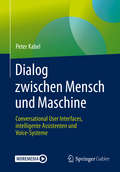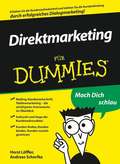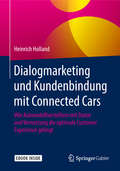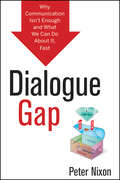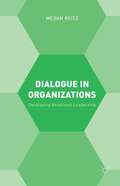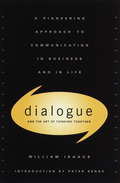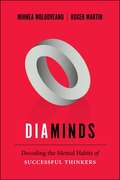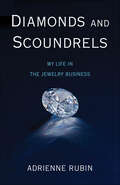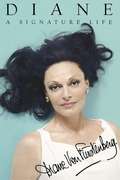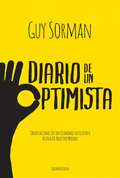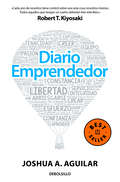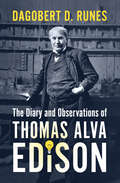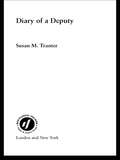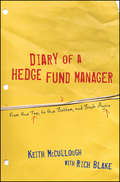- Table View
- List View
Dialog zwischen Mensch und Maschine: Conversational User Interfaces, intelligente Assistenten und Voice-Systeme
by Peter KabelDieses Buch beschreibt, wie sich die Interaktion zwischen Menschen und Maschinen in den nächsten Jahren dramatisch verändern wird und wie Unternehmen sowie Institutionen den größtmöglichen Nutzen aus dieser Entwicklung ziehen können.Conversational User Interfaces (CUI) sind die nächste Evolutionsstufe der Schnittstelle zwischen Menschen und den Inhalten oder Diensten des Internets. Wenn Nutzer in natürlicher Sprache mit ihnen reden, können intelligente Assistants, Voice-Systeme und Bots wertvolle Antworten geben und Handlungen auslösen: Sie buchen eine Fahrkarte, verlängern einen Vertrag oder starten eine Überweisung. So entsteht ein neues Ökosystem, das viele Prozesse in Unternehmen und im Alltag revolutionieren wird. Alle Marktteilnehmer müssen sich neu positionieren und verorten.Dieses Buch hilft dabei, die Funktionsweisen und Konsequenzen beim Einsatz von CUIs grundlegend zu verstehen und beantwortet unter anderem folgende Fragen: Woraus setzen sich CUIs und intelligente Assistenten zusammen? Wie funktioniert Natural Language Generation? Welche technischen Herausforderungen entstehen für Unternehmen? Welche Rolle spielt Werbung in dem neuen Ökosystem? Wie funktioniertder berührungslose Konsum? Eine inspirierende Lektüre, die Sie dabei unterstützt, sich in den nächsten Jahren unter den Leadern zu positionieren. Extra: eine Anleitung zum Gestalten Ihres eigenen Test-Bots – dem Friesenbot. Kostenlos für Leser: Testen Sie Ihr Wissen mit Fragen und Antworten zum Buch in der Springer-Nature-Flashcards-App.
Dialogic Organization Development: The Theory and Practice of Transformational Change
by Robert J. Marshak Gervase R. BusheA Dynamic New Approach to Organizational ChangeDialogic Organization Development is a compelling alternative to the classical action research approach to planned change. Organizations are seen as fluid, socially constructed realities that are continuously created through conversations and images. Leaders and consultants can help foster change by encouraging disruptions to taken-for-granted ways of thinking and acting and the use of generative images to stimulate new organizational conversations and narratives. This book offers the first comprehensive introduction to Dialogic Organization Development with chapters by a global team of leading scholar-practitioners addressing both theoretical foundations and specific practices.
Dialogmarketing Perspektiven 2022/2023: Tagungsband 15. wissenschaftlicher interdisziplinärer Kongress für Dialogmarketing
by Deutscher Dialogmarketing Verband e. V.Der Tagungsband „Dialogmarketing Perspektiven“ vereint aktuelle Fachbeiträge und Forschungsergebnisse des 15. wissenschaftlichen interdisziplinären Kongress für Dialogmarketing, den der DDV im September 2022 an der Goethe-Universität Frankfurt veranstaltete. Wissenschaftler aus unterschiedlichen Disziplinen, die zum Dialog- und Data-Driven-Marketing forschen, wurden hier in den Dialog miteinander gebracht und konnten sich mit Praktikern vernetzen.
Dialogmarketing für Dummies (Für Dummies)
by Andreas ScherfkeWie kann man heute sein Produkt an den Mann bringen oder die Kundin für seine Dienstleistung erreichen? Dialogmarketing heißt das Zauberwort! Dieses Buch stellt die ganze Bandbreite von Instrumenten des Dialogmarketing vor: vom klassischen Werbebrief über Telefonmarketing und Couponing bis hin zur Kundenzeitschrift. Natürlich werden die Planung und Konzeption von Kampagnen, die Adressenbeschaffung und -pflege sowie die rechtliche Seite nicht ausgespart. Fallstudien zu den Themen Kunden finden, Kunden binden und Kunden zurückgewinnen runden das Buch ab.
Dialogmarketing und Kundenbindung mit Connected Cars: Wie Automobilherstellern Mit Daten Und Vernetzung Die Optimale Customer Experience Gelingt
by Heinrich HollandLesen Sie in diesem Buch alles zum Thema Dialogmarketing und Kundenbindung hinsichtlich Connected Cars in der Automobilbranche. Das Auto der Zukunft ist mit der Umwelt sowie anderen Verkehrsteilnehmern vernetzt und Teil des Internet of Things. Mit Hilfe einer stetigen Internetverbindung sind Connected Cars dazu in der Lage, überall und permanent online zu sein. Da es im Bereich der digitalen Vernetzung mittlerweile hohen Innovationsdruck und einen starken Verdrängungswettbewerb gibt, liefern sich Fahrzeughersteller, Telekommunikationsanbieter sowie IT-Riesen heute einen echten Machtkampf um die Hoheit im Connected Car. Heinrich Hollands Buch über „Dialogmarketing und Kundenbindung mit Connected Cars - Wie Automobilherstellern mit Daten und Vernetzung die optimale Customer Experience gelingt“ zeigt die Potenziale von Autos mit Konnektivitätstechnologien in folgenden Bereichen auf: Digitale Dienstleistungen Kundenbindung Kundendialog Das ausführliche Dialogmarketing-Buch für die Automobilbranche beschreibt die Transformation vom Automobilhersteller zum Serviceanbieter mit zunehmender Bedeutung der produktbegleitenden Dienstleistungen. Im Zuge dessen macht Heinrich in seinem Buch ebenfalls deutlich, welche neuen Chancen sich für den Dialog mit den Kunden und die Kundenbindung durch Data Driven Marketing im Bereich der Connected Cars eröffnen. Aktuelle wissenschaftliche Erkenntnisse und praktische Orientierungshilfen Autor Heinrich Holland gibt der Automobilbranche ein wegweisendes Dialogmarketing-Buch an die Hand, um neue Geschäftspotenziale und Anwendungsfelder für das Marketing im Bereich des vernetzten Fahrens zu entdecken. Hierfür liefert das Werk ebenfalls: ü Aktuelle Forschungsergebnisse ü Analysen hinsichtlich Adoption und Akzeptanz durch die Endnutzer ü Praktische Orientierungshilfen für den Wirtschaftszweig Damit hilft dieser umfassende Ratgeber der Automobilindustrie dabei, sich die Chancen, den digitalen Wandel mit Connected Cars in Produkte, Wertschöpfungsketten und Geschäftsmodelle zu integrieren, optimal zunutze zu machen.
Dialogue Gap
by Peter NixonThe book that bridges the chasm between communication and understanding in negotiations For years Peter Nixon worked with people from all walks of life, teaching them the art of negotiation. But it soon became apparent that the issue was not negotiation itself, but dialogue between parties. We have become experts at sending information-via email, text message, Internet, TV, and other forms of media, communicating, but not engaging, in an active dialogue defined by collaborative thinking. In Dialogue Gap, Nixon explores this growing disconnect and its significance in an increasingly globalized world where the ability to engage with others-in order to address issues like climate change, cultural differences, etc. -has become essential. Helps the reader differentiate communication and dialogue Explores the make-up and causes of the "Dialogue Gap" and what constitutes "good" dialogue (the right people talking about the right issues in the right way at the right time and in the right place) Identifies the most common reasons people don't dialogue effectively and provides helpful tips on how to engage in more effective, productive dialogues Effective dialogue is essential for general success, ensuring that all key stakeholders-in business, politics, or elsewhere-get what they want in the most efficient and productive way possible. Looking at successful and failed dialogues the author has experienced first-hand in Asia, Europe, North America, the Caribbean, and the Middle East in both the public and private sector from across industries, Dialogue Gap provides essential information for making the most of your interactions with others.
Dialogue in Organizations
by Megan ReitzIn politics, business and wider society, 'better' leadership and dialogue are seen as antidotes to the paradoxical issues of the modern world. Dialogues in Organizations illustrates how the compulsion for 'busyness', the entrenched assumptions about who leaders are (and what they should do) and the adherence to implicitly-held cultural norms threaten the possibility of effective dialogue in our organizations. The quality of the leader-follower encounter is examined using an action research approach. The stories and images drawn from this process reveal the challenges faced in enabling dialogue and developing 'relational leadership' in organizations. This book explores how relationships at work impact us as human beings and how this helps and hinders us in our ambition to be the people we want to be.
Dialogue: The Art Of Thinking Together
by William IsaacsDialogue provides practical guidelines for one of the essential elements of true partnership--learning how to talk together in honest and effective ways. Reveals how problems between managers and employees, and between companies or divisions within a larger corporation, stem from an inability to conduct a successful dialogue.
Dialogue: The Ultimate Communication
by Harvard Business Review PressEffective business communication is not confined to writing and making presentations. In reality, business communication most often occurs more informally, between individuals and in various settings. This chapter reveals the value of these significant moments and offers three principles for successful one-on-one interactions.
Diaminds
by Mihnea Moldoveanu Roger L. MartinWhat constitutes successful thinking in business? What are some of the techniques used by top business minds in order to solve problems and create value? Diaminds breaks new ground in addressing these questions.Mihnea Moldoveanu and Roger Martin, creators of the Integrative Thinking curriculum at the Rotman School of Management, draw upon case studies and interviews - as well as theories and models from cognitive psychology, epistemology, analytic philosophy, and semiotics - to offer a new conception of successful intelligence that is immediately applicable to business situations. The 'diamind' (or dialogical mind) is characterized by bi-stability (simultaneously holding opposite plans, models, courses of action in mind while retaining the ability to act), meliorism (increasing the logical depth and informational breadth of one's thinking processes), choicefulness (retaining the ability to choose among various representations of the world, the self and others) and polyphony (thinking about the way one formulates and solves a problem while at the same time thinking about the problem itself). End-of-chapter exercises encourage readers to examine and re-engineer their own thought and perception patterns to develop these qualities and cultivate their own 'diaminds.'
Diamond Foods
by David E. Bell Mary ShelmanCEO Michael Mendes has transformed a grower-owned cooperative into a publicly traded top marketer of snack foods. Diamond's organization, culture, product development process, advertising and promotion strategy, and specifically its marketing department have been built "from the ground up" to address fundamental changes in retail structure and consumer behavior. Can the Diamond model be successfully applied to other food categories?
Diamond Foods, Inc.
by Suraj Srinivasan Tim GrayThe Diamonds Foods, Inc. case describes the major accounting blow up at the company in late 2011 that was triggered by a report by Off Wall Street, a prominent short selling research firm. Diamond Foods, a high flying growth company in 2011, grew from a walnut farmers' cooperative in 2005 into a branded snack foods manufacturer on the strength of a series of acquisitions. The accounting scandal that involved improper accounting for walnut purchases led to Diamond dropping its high profile acquisition of Pringles, an SEC and DOJ investigation, departure of the CEO and CFO, and the grounding of a high flying growth company. The case describes the history and growth of the company, the investigative and analytical work conducted by OWS and allows students to understand implications of the growth strategy for financial performance and valuation. Additionally, the case highlights the role of corporate boards and audit committees in managing strategic and financial reporting risks.
Diamond Framework: A New Model for Project Management
by Aaron J. Shenhar Dov DvirThis chapter introduces the diamond model for managing projects in detail, showing how a diamond analysis can serve as an upfront assessment of benefits and risks and as a disciplined planning tool.
Diamonds and Scoundrels: My Life in the Jewelry Business
by Adrienne RubinWhen Adrienne Rubin enters into the jewelry business in 1970s Los Angeles, she is a maverick in a world dominated by men. She soon meets a young hotshot salesman who doesn’t seem to struggle at all, and when he asks her to be his partner, she is excited to join him. She doesn’t know him well, but she does know his father, and she believes he is as trustworthy as the day is long . . . Diamonds and Scoundrels shows us how a woman in a man’s world, with tenacity and sheer determination, can earn respect and obtain a true sense of accomplishment. Following Rubin’s experiences in the jewelry industry through the ’70s, ’80s, and ’90s—with the ups and downs, good guys and bad—this is a tale of personal growth, of how to overcome challenges with courage and resilience. It’s a story for the woman today who, in addition to a rich family life, seeks a self-realized, fulfilling path toward a life well lived.
Diamonds and War: State, Capital, and Labor in British-Ruled Palestine
by David De VriesThe mining of diamonds, their trading mechanisms, their financial institutions, and, not least, their cultural expressions as luxury items have engaged the work of historians, economists, social scientists, and international relations experts. Based on previously unexamined historical documents found in archives in Belgium, England, Israel, the Netherlands, and the United States, this book is the first in English to tell the story of the formation of one of the world’s main strongholds of diamond production and trade in Palestine during the 1930s and 1940s. The history of the diamond-cutting industry, characterized by a long-standing Jewish presence, is discussed as a social history embedded in the international political economy of its times; the genesis of the industry in Palestine is placed on a broad continuum within the geographic and economic dislocations of Dutch, Belgian, and German diamond-cutting centers. In providing a micro-historical and interdisciplinary perspective, the story of the diamond industry in Mandate Palestine proposes a more nuanced picture of the uncritical approach to the strict boundaries of ethnic-based occupational communities. This book unravels the Middle-eastern pattern of state intervention in the empowerment of private capital and recasts this craft culture’s inseparability from international politics during a period of war and transformation of empire.
Diane: A Signature Life
by Diane Von FurstenbergThe frank and compelling story of an extraordinary woman and her adventures in fashion, business, and life.“Most fairy tales end with the girl marrying the prince. That's where mine began,” says Diane Von Furstenberg. Von Furstenberg lived the American Dream before she was thirty, building a multimillion-dollar fashion empire while raising two children and living life in the fast lane. Her wrap dress, a cultural phenomenon in the seventies, hangs in the Smithsonian Institution; her entry into the beauty business in 1979 was as serendipitous and as successful. Von Furstenberg learned her trade in the trenches, crisscrossing the country to make personal appearances at department stores, selling her dresses and cosmetics. That business had its ups and downs, as the fashionista entrepreneur’s unparalleled success became the source of its own undoing and she contended with bankruptcy, the loss of her business, and finally a complete self-reinvention that took her back to the top of the industry. This revealing and contemplative memoir works to make sense of the contradictions of the author’s life: glamour vs. hard work, European vs. American, daughter of a Holocaust survivor vs. wife of an Austro-Italian prince, mother vs. entrepreneur, lover vs. tycoon. She emerges wiser, stronger, and ever more determined never to sacrifice her passion for life.
Dianrong: Marketplace Lending, Blockchain, and "The New Finance" in China
by Lauren H. Cohen Christopher Malloy Anthony K. WooThis case examines the strategic positioning of Dianrong, one of the largest online peer-to-peer (P2P) lending platforms in China, in its attempt to become a foundational player in the expansion of the FinTech sector in Asia. Dianrong had recently announced the acquisition of the asset-origination operations of Shanghai-based Quark Finance, augmenting Dianrong’s asset management and credit evaluation capabilities across China, as well as a new initiative to develop the first blockchain platform for supply chain finance in China. The goal was to provide capital to smaller suppliers in the supply chain, and provide enhanced visibility and transparency of supply chains for large multinational manufacturers. The company had also made several recent forays into other related sectors, with their creation of “DR Group” as an umbrella corporate structure that included all wholly-owned businesses, joint ventures, and partnerships. This rebranded group structure encompassed the various aspects of “The New Finance,” leveraging FinTech innovation to deliver value for borrowers, lenders, and investors. Case protagonist Soul Htite, Founder and CEO of Dianrong, and the former CTO of Lending Club, must decide how to execute on the firm’s aggressive diversification plan. Recent advances at the company, while promising, were complicated by the uncertainties in the political and regulatory landscape. How should the company leverage its advantage in technology and position itself in the market? Which sectors within its larger umbrella structure were the most promising avenues to focus on? Was Dianrong tackling too many sectors and problems at once? Htite’s view was that in order to truly succeed in China a technology company had to “create” much of the ecosystem and infrastructure oneself, as opposed to in the US where companies could simply “provide add-ons” to existing firms and capabilities. But the reality of trying to excel in so many different areas was daunting.
Dianrong: Marketplace Lending, Blockchain, and "The New Finance" in China
by Lauren H. Cohen Anthony K. Woo Christopher J. MalloyThis case examines the strategic positioning of Dianrong, one of the largest online peer-to-peer (P2P) lending platforms in China, in its attempt to become a foundational player in the expansion of the FinTech sector in Asia. Dianrong had recently announced the acquisition of the asset-origination operations of Shanghai-based Quark Finance, augmenting Dianrong's asset management and credit evaluation capabilities across China, as well as a new initiative to develop the first blockchain platform for supply chain finance in China. The goal was to provide capital to smaller suppliers in the supply chain, and provide enhanced visibility and transparency of supply chains for large multinational manufacturers. The company had also made several recent forays into other related sectors, with their creation of "DR Group" as an umbrella corporate structure that included all wholly-owned businesses, joint ventures, and partnerships. This rebranded group structure encompassed the various aspects of "The New Finance," leveraging FinTech innovation to deliver value for borrowers, lenders, and investors. Case protagonist Soul Htite, Founder and CEO of Dianrong, and the former CTO of Lending Club, must decide how to execute on the firm's aggressive diversification plan. Recent advances at the company, while promising, were complicated by the uncertainties in the political and regulatory landscape. How should the company leverage its advantage in technology and position itself in the market? Which sectors within its larger umbrella structure were the most promising avenues to focus on? Was Dianrong tackling too many sectors and problems at once? Htite's view was that in order to truly succeed in China a technology company had to "create" much of the ecosystem and infrastructure oneself, as opposed to in the US where companies could simply "provide add-ons" to existing firms and capabilities. But the reality of trying to excel in so many different areas was daunting.
Diario de un optimista: Observaciones de un economista filósofo acerca de nuestro mundo
by Guy SormanEn estos artículos sobre la cultura y el mundo contemporáneos, Sorman,autoproclamado «optimista en tiempos de crisis» y defensor de la idea deprogreso, no pierde, sin embargo, su mirada crítica y su escrituraprovocadora y lacerante. Se trata de la mirada original y desprejuiciadade un «etnólogo del tiempo presente», como alguna vez lo definió elpropio Claude Lévi-Strauss, uno de sus maestros. «Si tuviera que resumir estos últimos años en una fórmula simple,propondría la siguiente: crisis de Occidente y occidentalización delmundo. Mientras aquí, en Occidente, nos sentimos cada vez más perplejosrespecto de nuestro futuro económico, nuestra identidad cultural ynuestras democracias disfuncionales, el resto del mundo se lanza aimitar nuestras instituciones y nuestros modos», dice el prestigiosofilósofo francés Guy Sorman en el prólogo de este libro.«Para quienes lo vemos desde adentro, Occidente es sinónimo de crisis;para quienes lo ven desde afuera, es sinónimo de libertad. Las crisis yla libertad indudablemente marchan juntas».
Diario emprendedor
by Joshua A. AguilarEste libro trata acerca de cómo emprender tus más grandes sueños, acerca de los emprendedores y lo que los hace diferentes, y está dirigido tanto a quienes ya han iniciado el camino como a los que les gustaría llegar a hacerlo. Contiene treinta valiosos capítulos, uno para cada día durante un mes, con historias impresionantes, situaciones humorísticas, ejemplos de la vida real y preguntas para reflexionar que te mantendrán enganchado a la lectura. El fenómeno mundial de autoayuda y finanzas para empresas y particulares. En este libro encontrarás treinta capítulos con anécdotas y ejemplos de emprendedores. Además, es un diario que te permite organizarte. Se titula Diario Emprendedor porque tendrás la oportunidad de escribir todas tus ideas y planes de acción gracias al apartado "Diario personal" que encontrarás al final de cada capítulo. Mediante la reflexión sobre cada tema sentarás las bases de tus proyectos y descubrirás un camino propio hacia tus metas. De manera que este diario no trata sobre el autor, trata sobre ti, es tu diario. Solo en ocasiones especiales se presentan libros que de pronto cambian tu vida radicalmente; ahora mismo tienes uno en tus manos. Diario Emprendedor es el punto de partida para aquellos que quieren alcanzar sus sueños y metas más grandes. ¿Qué esperas para empezar a conquistar tu éxito? "Los emprendedores abren nuevos caminos, empiezan donde están, son autodidactas, asumen riesgos; mientras los demás retroceden, ellos avanzan, el miedo no los detiene, sino que los motiva a seguir adelante. Sus vidas están controladas por la ilusión de dejar una huella y hacer de este mundo un lugar mejor, ellos hacen lo que los demás desearían hacer pero no se atreven". Lo que han dicho otros autores: "Cada uno de nosotros tiene control sobre una sola cosa: nosotros mismos. Todos aquellos que tengan un sueño deberían leer este libro". - Robert T. Kiyosaki, autor del bestseller Padre Rico, Padre Pobre Lo que han dicho los lectores: "Este libro está lleno de fuerza y de ganas de hacer. ¡Me alegro de haberlo leído!" "Uno de los mejores libros de motivación que he leído. Es de esos libros que te hacen levantarte de la cama y pensar en el tiempo que perdemos y la importancia que le damos a cosas que no la tienen". "Yo, gracias a ti, he cambiado mi forma negativa de afrontar todos mis proyectos con miedo a fracasar y he empezado a pensar en grande. Gracias de corazón". "Libros como este son los que hacen falta para tiempos como estos".
Diary Of An Ad Man: The War Years June 1, 1942-December 31, 1943
by James W. YoungAn Advertising Classic from One of Advertising's Greats. On the way to his ranch in New Mexico in the spring of 1942, James Webb Young (1886-1973) stopped in Chicago and over Lunch told George Crain about a book he wanted to write--a history of American business from an advertising man's point of view. Mr. Crain was encouraging and urged Young to begin writing as soon as possible. Advertising Age would publish his account in weekly installments. Beginning the routine of daily notes for such a book, Young found himself handicapped by the lack of historical reference material. As a result, the daily notes began to take on a current flavor; and this led eventually to the Diary as a way to appease Crain's importunities for the promised material. The Diary ran in Advertising Age anonymously because Young felt that would give him more freedom of expression, and involve him in less labor over controversial subjects. It was first printed in book form in 1944. During his lifetime, James Webb Young, senior consultant and a director of the J. Walter Thompson Company, was universally recognized as the dean of American advertising. His concepts, ideas, and experiences continue to shape the profession. Two of his works, How to Become an Advertising Man and A Technique for Producing Ideas, have been especially influential. Mr. Young has an incisive view of human nature, is especially observant and open-minded. Witty, like Mark Twain. Each day in the diary is just one paragrphy of pithy observations.
Diary and Observations of Thomas Alva Edison
by Dagobert D. RunesGain insight into the unique thinking and philosophy of the world&’s most prolific inventor with this collection of his writings.American scientist and businessman Thomas Edison contributed much to the well-being and comfort of our modern life. He gave us the electric light, the phonograph, and the motion-picture camera, along with more than one thousand other inventions. Edison was, as fellow inventor Guglielmo Marconi put it, &“one of the world&’s greatest benefactors.&” In this volume, editor Dagobert D. Runes presents Edison&’s diary along with a selection of his social and philosophical ideas taken from available notes, statements, and observations. Readers will discover that many of Edison&’s casual remarks made decades ago have a definite contemporary significance. His propositions in ethics, philosophy, music, and education show a rare combination of whimsy and deep sincerity.
Diary of A Deputy
by Susan M. TranterFirst Published in 2004. Routledge is an imprint of Taylor & Francis, an informa company.
Diary of a Hedge Fund Manager: From the Top, to the Bottom, and Back Again
by Rich Blake Keith McculloughA fast-paced ride through the world of hedge funds revealing the unvarnished truth of how Wall Street really operates, and how to use this to your advantageAn insider's view of the high stakes world of money management, Diary of a Hedge Fund Manager is both a practical guide for investors and the deeply personal story of a man who knows the system inside and out. One of the best young portfolio managers on Wall Street, and helping to run the hedge fund operation of one of the world's most prestigious firms, Keith McCullough finds himself a lone voice of reason as the economic crisis of 2008 looms large. Shown the door, his life takes a fascinating turn into the world of independent research and no-holds-barred criticism.Reveals the unvarnished truth of how Wall Street and hedge funds really operateDeftly details how to analyze the markets expertly and avoid group think using technical and fundamental measuresEach topic is thoroughly discussed and followed up with lessons you can take away and put to useWritten with the authority of someone who knows how Wall Street and hedge funds work, yet accessible to even a casual follower of finance, Diary of a Hedge Fund Manager mixes a constructive critique of the investment industry with fundamental lessons that any investor will find valuable.
